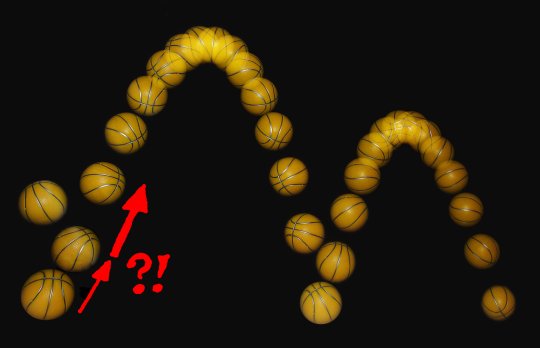Over at Kevin Koch’s always excellent Synchrolux blog, there’s a discussion brewing about a new course being offered by professor Alej Garcia at San Jose State University about the physics of animation. I love the idea of this course, and I also love the openness with which Professor Garcia is engaging with animators to get the ideas and terminology exactly right, via Kevin’s blog and elsewhere. When scientists and artists get together, good things happen!
Part of the discussion has revolved around a certain stroboscopic photo of a bouncing ball:

Kevin pointed out that the ball’s arc looked strange to him, and a wonderful discussion ensued. The question in my mind was why there appeared to be a sudden change in direction and speed between the second and third “frames” of the ball’s movement. The best explanation I’ve been able to come up with is that none of the strobe’s flashes happened to coincide with the exact moment when the ball hit the ground:

This brings up a really important distinction between animation and film. In live-action film (or in strobe photography) the camera captures whatever happens to be in front of it every 24th of a second, regardless of whether the image captured in that instant is particularly interesting or important. Only one instant is captured, and the rest of what happens in that 1/24-second interval is lost. In animation, the expectations are higher: we expect each frame to do the best possible job of telling the story of what happens in the entire interval. In the case of a bouncing ball, the most important part is clearly the instant when the ball hits the ground–not what happens a few milliseconds earlier or later! The strobe photo above might be a technically accurate representation of a bouncing ball, but it does a poor job of conveying the whole truth to the audience, because the most salient moments–the bounces–are misrepresented. This is just one of many reasons why animation has something that live action (or pure motion capture) will never quite match.

Thanks Cassidy, your analysis makes a lot of sense. And I agree with your point regarding animation versus pure motion capture. Looking carefully at the photo my sense is that at the lowest photo flash on the left is just before the ball makes its first bounce. The lowest photo flash near the center seems to be just before the second bounce. But even knowing this the image creates some multistable perception (see http://en.wikipedia.org/wiki/Multistable_perception) which is visually jarring. I’m not an animator but it seems that some of the principles of animation, such as squash and stretch, work well because they eliminate these distracting visual ambiguities. Alej
PS Thank you for your nice comments regarding the “Physics of Animation” course that we’re developing at SJSU.